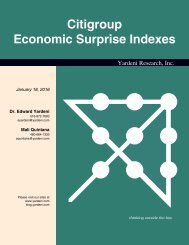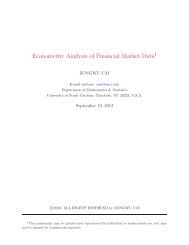Illiquid Asset Investing 1. Liquidating Harvard
Illiquid Asset Investing 1. Liquidating Harvard
Illiquid Asset Investing 1. Liquidating Harvard
You also want an ePaper? Increase the reach of your titles
YUMPU automatically turns print PDFs into web optimized ePapers that Google loves.
Andrew Ang <strong>Illiquid</strong> <strong>Asset</strong> <strong>Investing</strong> <strong>Asset</strong> Management<br />
process only involves averaging returns for this period and the past period, then we can filter the<br />
observed returns to estimate the true returns, r t , from observed returns,<br />
1 * *<br />
rt rt rt<br />
<strong>1.</strong><br />
1 1 <br />
<br />
<br />
14<br />
*<br />
r t , using:<br />
Equation (2) unsmooths the observed returns. If our assumption on the transfer function is right,<br />
the observed returns implied by equation (2) should have zero autocorrelation. Thus, the filter<br />
takes an autocorrelated series of observed returns and produces true returns that are close to<br />
I.I.D. Note that the variance of the true returns is higher than the observed returns:<br />
1<br />
<br />
1<br />
var( rt) <br />
2<br />
2<br />
* *<br />
var( rt ) var(<br />
rt<br />
),<br />
since | | 1,<br />
so we are adding variance to the observed returns to produce estimates of the true<br />
returns.<br />
The unsmoothing process has several important properties:<br />
<strong>1.</strong> Unsmoothing only affects risk estimates and not expected returns.<br />
Intuitively, estimates of the mean require only the first and last price observation (with<br />
dividends take “total prices” which count reinvested dividends). 11 In Figure 2, we can see<br />
that the first and last observations are unchanged by infrequent sampling; thus<br />
unsmoothing only changes the volatility estimates.<br />
2. Unsmoothing has no effect if the observed returns are uncorrelated.<br />
11<br />
Technically taking means of both the right- and left-sides in equation (2) results in the same means in large<br />
samples.<br />
(<strong>1.</strong>2)<br />
(<strong>1.</strong>3)




